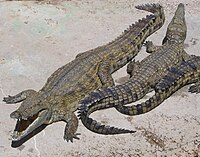
Photo from wikipedia
Animals trade-off predation risk against feeding opportunities and prey species may use signals or cues of predators to assess predation risk. We analyzed the mesopredators pine and stone marten (Martes… Click to show full abstract
Animals trade-off predation risk against feeding opportunities and prey species may use signals or cues of predators to assess predation risk. We analyzed the mesopredators pine and stone marten (Martes martes, M. foina) and nocturnal and diurnal rodents (Glis glis, Apodemus spp., Sciurus vulgaris). The non-experimental approach used camera traps at feeders which were visited by both, predator and prey. As prey species can eavesdrop on predator signals/cues, there should show some avoidance behavior. The study was conducted on a small mountain in Germany, largely covered by wood, between 29.6.2018 and 5.10.2018. Camera traps were placed 0.6 m near a feeder. Food was replenished regularly to provide a continuous food supply. 34 camera traps provided data for an analysis; total trap nights were 513 (12,312 h). Martens detected the food sources first in 10 instances, and prey species Apodemus/G. glis in 24 instances. G. glis seemed to generally avoid places where martens were feeding while Apodemus and Sciurus did not. The visitations of G. glis depended on whether martens were the first visitors and it significantly avoided such places. Similarly, Apodemus appeared less often at a feeder when martens have been present as a first visitor. The time interval to resume feeding to a monitored feeder after a marten visit was significantly longer compared to a control in G. glis, but not in Apodemus and S. vulgaris. The study shows different responses, with the weakest in the diurnal rodent, and the highest in G. glis. Thus, if a food resource was known by prey species before a predator occurred, the trade-off was shifted towards feeding, but when the predators detect the food source first, the trade-off was shifted to predator avoidance.
Journal Title: Behavioural Processes
Year Published: 2020
Link to full text (if available)
Share on Social Media: Sign Up to like & get
recommendations!